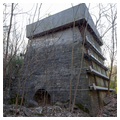This is the most remarkable collection of early-nineteenth-century iron furnace plantation buildings in western Pennsylvania. The ironmaster's home and office, workers' housing, and a working farm survive. More remarkably, all continue to be used as either homes or farm buildings. The entire complex is relatively isolated along Casselberry Road adjacent to Roaring Run. A canal lock survives one mile to the south at the Juniata River. The pyramidal stone furnace, built between 1805 and 1809, operated until 1877. Most of the limestone, gable- or pyramidal-roofed buildings were constructed during the ownership of Henry S. Spang between 1827 and 1846. The entire complex was owned by the Isett family of Sinking Valley ( BL26) until World War II, when the farm portion with its handsome stone barn was sold. It is an astonishing assemblage of buildings embodying the core story of the industrial development of western Pennsylvania.
You are here
Mt. Etna Furnace and Iron Plantation
1805–1809, 1827–1846. Casselberry Rd and PA 2017 NW, 6.4 miles north–northeast of Williamsburg
If SAH Archipedia has been useful to you, please consider supporting it.
SAH Archipedia tells the story of the United States through its buildings, landscapes, and cities. This freely available resource empowers the public with authoritative knowledge that deepens their understanding and appreciation of the built environment. But the Society of Architectural Historians, which created SAH Archipedia with University of Virginia Press, needs your support to maintain the high-caliber research, writing, photography, cartography, editing, design, and programming that make SAH Archipedia a trusted online resource available to all who value the history of place, heritage tourism, and learning.


















